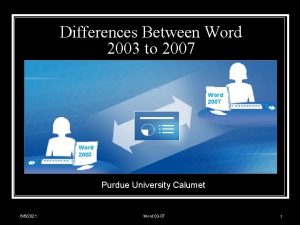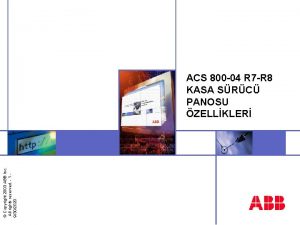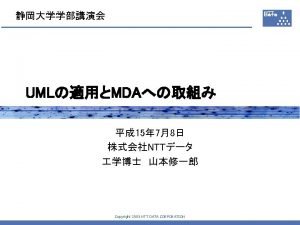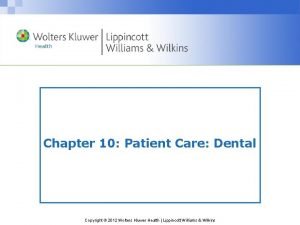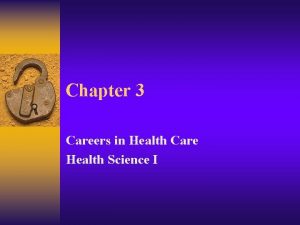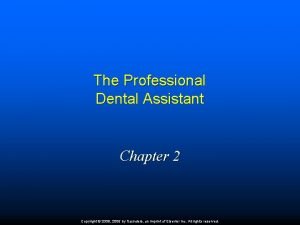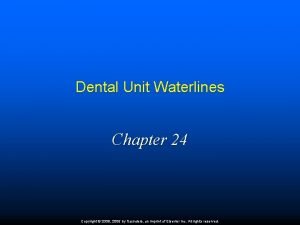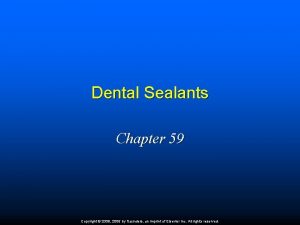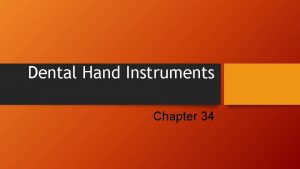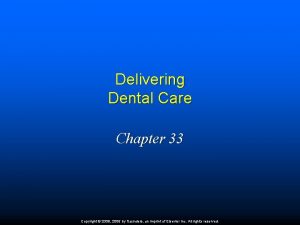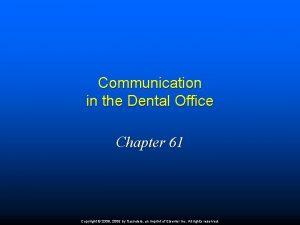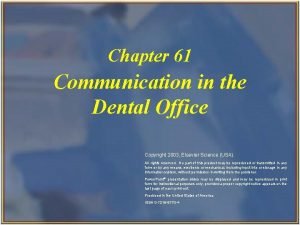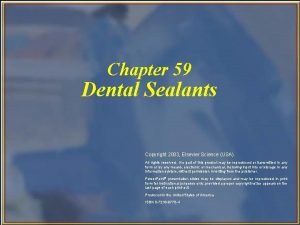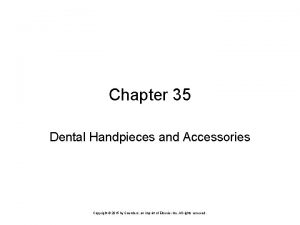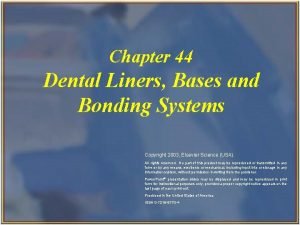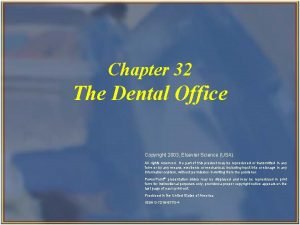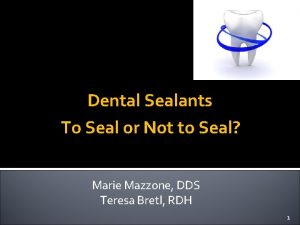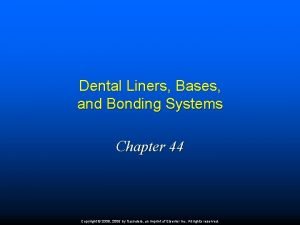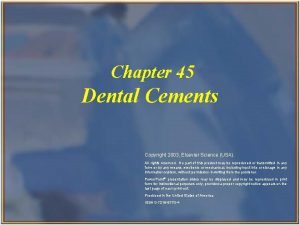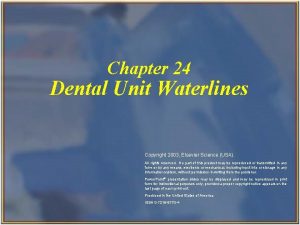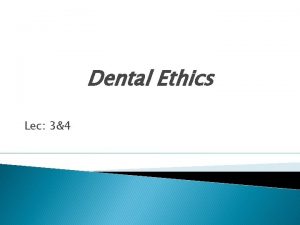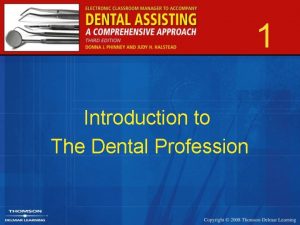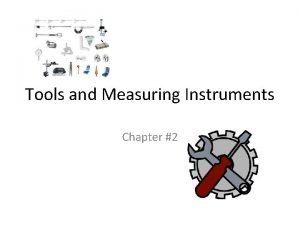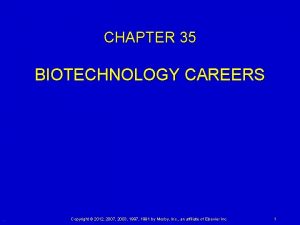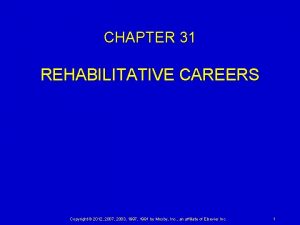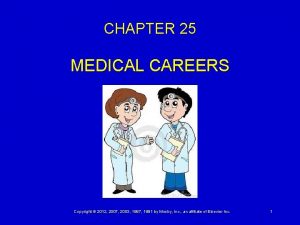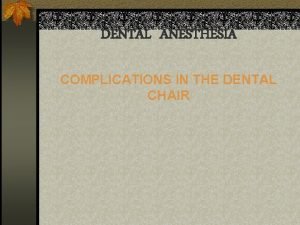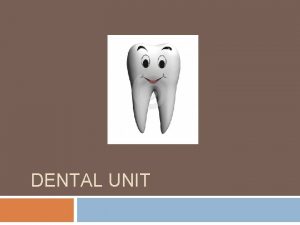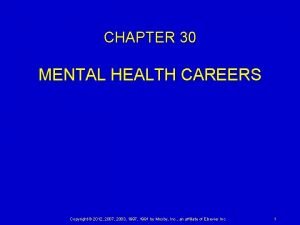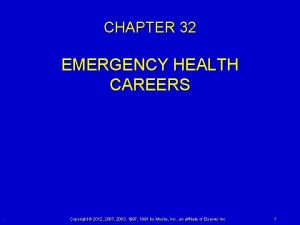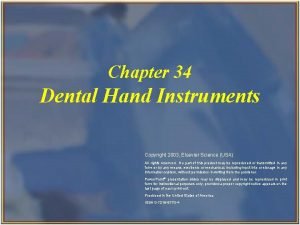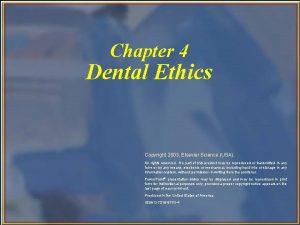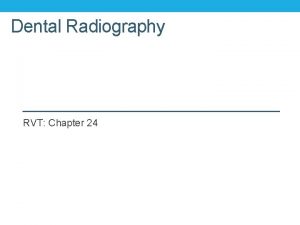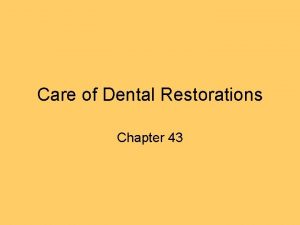CHAPTER 26 DENTAL CAREERS Copyright 2012 2007 2003







































- Slides: 39

CHAPTER 26 DENTAL CAREERS Copyright © 2012, 2007, 2003, 1997, 1991 by Mosby, Inc. , an affiliate of Elsevier Inc. 1

Chapter 26 Learning Objectives Define at least 10 terms relating to dental health care. Specify the role of the dentist, dental hygienist, dental assistant, and dental laboratory technician, including personal qualities, levels of education, and credentialing requirements. Copyright © 2012, 2007, 2003, 1997, 1991 by Mosby, Inc. , an affiliate of Elsevier Inc. 2

Chapter 26 Learning Objectives Identify the difference between the dentition of the child and adult. Identify at least five structures of the oral cavity. Describe the location, structure, and function of four types of teeth. Copyright © 2012, 2007, 2003, 1997, 1991 by Mosby, Inc. , an affiliate of Elsevier Inc. 3

Chapter 26 Learning Objectives Chart at least three types of dental variations using a selected method of charting. Describe methods of prevention and detection of caries and periodontal disease. Describe techniques of brushing and flossing to promote dental health. Copyright © 2012, 2007, 2003, 1997, 1991 by Mosby, Inc. , an affiliate of Elsevier Inc. 4

Careers in Dentistry The goal of the dental team is to provide optimal care of the oral cavity for all patients. Dental team members can work in Group or specialty practice Ø Schools Ø Government or community clinics Ø Dental insurance companies Ø Copyright © 2012, 2007, 2003, 1997, 1991 by Mosby, Inc. , an affiliate of Elsevier Inc. 5

Dental Careers Copyright © 2012, 2007, 2003, 1997, 1991 by Mosby, Inc. , an affiliate of Elsevier Inc. 6

Dental Careers Education Costs and Earnings Copyright © 2012, 2007, 2003, 1997, 1991 by Mosby, Inc. , an affiliate of Elsevier Inc. 7

Dentist Education Ø Ø 4 -year degree from college or university 3 to 4 years of dental school training 2 years of additional training for specialty National examination required for licensure Degrees Doctor of Dental Surgery (DDS) Ø Doctor of Medical Dentistry (DMD) Ø Copyright © 2012, 2007, 2003, 1997, 1991 by Mosby, Inc. , an affiliate of Elsevier Inc. 8

Nine Specialties of Dentistry Endodontics Ø Oral and maxillofacial surgery Ø Extraction and treatment of injury, disease, and deformity of the mouth Oral pathology Ø Treatment of disease of the dental pulp Laboratory testing and biopsy to diagnose oral conditions Orthodontics Ø Prescription and fitting of braces to correct misaligned teeth or jaws Copyright © 2012, 2007, 2003, 1997, 1991 by Mosby, Inc. , an affiliate of Elsevier Inc. 9

Nine Specialties of Dentistry Pedodontics Ø Periodontics Ø Prevention of disease and decay and therapeutic care of children’s teeth Treatment of gum disease Prosthodontics Ø Design and fitting of bridgework and dentures, as well as substitutes for missing teeth or tissue Copyright © 2012, 2007, 2003, 1997, 1991 by Mosby, Inc. , an affiliate of Elsevier Inc. 10

Nine Specialties of Dentistry Public health dentistry Ø Promotion of prevention and treatment of dental disease Oral and maxillofacial radiology Ø Includes the diagnosis and treatment of oral and maxillofacial disorders using radiation Copyright © 2012, 2007, 2003, 1997, 1991 by Mosby, Inc. , an affiliate of Elsevier Inc. 11

Dental Hygienist Role of the dental hygienist includes: Recording patient’s health history Ø Removing calculus and plaque Ø Examining teeth and oral structures Ø Polish and floss the teeth Ø May apply fluoride treatment to teeth Ø Oral cancer and blood pressure screening Ø Expose, process, and may interpret dental radiographs Ø Instruct patients on procedures for home care Ø May place temporary fillings, fluoride, or sealants Ø Copyright © 2012, 2007, 2003, 1997, 1991 by Mosby, Inc. , an affiliate of Elsevier Inc. 12

Dental Hygienist Education 2 -year community college Ø 4 -year college or university program Ø Completion of accredited program and national examination for state licensing Ø Copyright © 2012, 2007, 2003, 1997, 1991 by Mosby, Inc. , an affiliate of Elsevier Inc. 13

Dental Assistant Functions Answering phone and making appointments Ø Recording dental history Ø Maintaining infection control Ø Exposing radiographs Ø Assisting with procedures Ø Cleaning and sterilizing equipment Ø Exposing radiographs Ø Education 1 - to 2 -year accredited program Ø Certification through the Dental Assisting National Board Ø Copyright © 2012, 2007, 2003, 1997, 1991 by Mosby, Inc. , an affiliate of Elsevier Inc. 14

Cleaning and Sterilizing Dental Instruments FIGURE 26 -3 Cleaning and sterilizing dental instruments are part of the dental assistant’s role. Copyright © 2012, 2007, 2003, 1997, 1991 by Mosby, Inc. , an affiliate of Elsevier Inc. 15

Dental Laboratory Technician The work of a dental laboratory technician involves Making prostheses as ordered by dentist Ø Work that involves minute detail and manual dexterity Ø Education Primarily on-the-job training Ø Certification available through the National Association of Dental Laboratories Ø Copyright © 2012, 2007, 2003, 1997, 1991 by Mosby, Inc. , an affiliate of Elsevier Inc. 16

Content Instruction Maintaining dental health Cavities (caries) are inflammation or disease of the inner tooth Ø Periodontal disease Ø • Major cause is the formation of bacterial plaque Plaque is colorless and develops in 24 hours Plaque hardens and becomes tartar • Most common types Gingivitis Periodontitis Copyright © 2012, 2007, 2003, 1997, 1991 by Mosby, Inc. , an affiliate of Elsevier Inc. 17

Dental Caries and Gingivitis FIGURE 26 -5 Dental caries and gingivitis develop as plaque is pushed into the soft tissues that support the mouth. Copyright © 2012, 2007, 2003, 1997, 1991 by Mosby, Inc. , an affiliate of Elsevier Inc. 18

Flossing Instruction FIGURE 26 -6 Flossing instruction is made easier with an enlarged model of teeth. Copyright © 2012, 2007, 2003, 1997, 1991 by Mosby, Inc. , an affiliate of Elsevier Inc. 19

Structures of the Oral Cavity Structures of the oral cavity Teeth are located in sockets (alveoli) of the mandible and maxilla. Ø Sinuses are air cavities. Ø Mouth is covered with mucous membrane. Ø Roof of the mouth is divided into two portions: Ø • Anterior (hard palate) • Posterior (soft palate) Copyright © 2012, 2007, 2003, 1997, 1991 by Mosby, Inc. , an affiliate of Elsevier Inc. 20

Structures of the Oral Cavity FIGURE 26 -8 Structures of the oral cavity (the frenulum cannot be seen below the tongue). Copyright © 2012, 2007, 2003, 1997, 1991 by Mosby, Inc. , an affiliate of Elsevier Inc. 21

Tooth Formation Tooth formation begins during the second month of gestation. At birth, the neonate has 44 teeth buds. Ø 20 deciduous teeth begin to erupt at 6 months. Ø Most deciduous teeth erupt by age 2. Ø Permanent teeth replace the deciduous teeth by the 12 th year. Ø Copyright © 2012, 2007, 2003, 1997, 1991 by Mosby, Inc. , an affiliate of Elsevier Inc. 22

Identification of Teeth FIGURE 26 -9 Identification of teeth with eruption times (anterior teeth are shaded). Copyright © 2012, 2007, 2003, 1997, 1991 by Mosby, Inc. , an affiliate of Elsevier Inc. 23

Structures of the Tooth The tooth is divided into two sections. Ø Crown • Outside is covered with shiny, white enamel (composed of calcium and phosphorus). • Middle layer, composed of dentin, reacts to touch, temperature, and chemical stimulation. • Inside layer and root is made of soft tissue (pulp). Pulp contains the nerves and blood vessels of the tooth. Copyright © 2012, 2007, 2003, 1997, 1991 by Mosby, Inc. , an affiliate of Elsevier Inc. 24

Structures of the Tooth Ø Root • Outside is covered in cementum, which anchors the • • tooth. Cervix of the tooth is the narrowed area where the enamel of the crown and cementum of the root join. Inside layer of the crown and root is made of pulp. The periodontal ligament holds the tooth in place. Gingiva is the gum tissue around the root of the tooth. Copyright © 2012, 2007, 2003, 1997, 1991 by Mosby, Inc. , an affiliate of Elsevier Inc. 25

Structure of a Molar Tooth FIGURE 26 -10 Structure of a molar tooth. Copyright © 2012, 2007, 2003, 1997, 1991 by Mosby, Inc. , an affiliate of Elsevier Inc. 26

Identification of Teeth Maxillary teeth are teeth in the upper jaw. Mandibular teeth are in the lower jaw. Incisors and cuspids are anterior. Bicuspids and molars are posterior. Each tooth can be named individually by its type and location. Five surfaces of the crown can be used to locate a defect or structure of the crown. Copyright © 2012, 2007, 2003, 1997, 1991 by Mosby, Inc. , an affiliate of Elsevier Inc. 27

Five Surfaces of the Crown FIGURE 26 -11 A, Five surfaces of the crown. Copyright © 2012, 2007, 2003, 1997, 1991 by Mosby, Inc. , an affiliate of Elsevier Inc. 28

Surface of a Posterior Crown FIGURE 26 -11 B, Surface of a posterior crown (lingual side is not visible). Copyright © 2012, 2007, 2003, 1997, 1991 by Mosby, Inc. , an affiliate of Elsevier Inc. 29

Identification of Teeth Universal system for numbering teeth Numbered 1 to 32 Ø Primary teeth are lettered A to T Ø Other systems Federation Dentaire International System Ø Palmer System Ø Copyright © 2012, 2007, 2003, 1997, 1991 by Mosby, Inc. , an affiliate of Elsevier Inc. 30

Universal System of Tooth Identification FIGURE 26 -12 Universal system of tooth identification. Copyright © 2012, 2007, 2003, 1997, 1991 by Mosby, Inc. , an affiliate of Elsevier Inc. 31

Performance Instruction Use of radiographs Lasers Digital images Electronic dental anesthesia Charting of dental conditions Preparing the dental operatory and equipment Disinfecting surface areas and sterilizing dental instruments Preparing dental materials Copyright © 2012, 2007, 2003, 1997, 1991 by Mosby, Inc. , an affiliate of Elsevier Inc. 32

Intraoral Camera FIGURE 26 -13 The intraoral camera allows the dental health worker and patient to see the tooth structure on a larger scale. (Courtesy Joyce Bassett, DDS, FAGD, Scottsdale, Ariz. ) Copyright © 2012, 2007, 2003, 1997, 1991 by Mosby, Inc. , an affiliate of Elsevier Inc. 33

Clinical Examination Form FIGURE II-5 Clinical examination form. A, Front. (Courtesy Colwell, a Division of Patterson Dental Supply Inc. , St. Paul, Minn. ) Copyright © 2012, 2007, 2003, 1997, 1991 by Mosby, Inc. , an affiliate of Elsevier Inc. 34

Clinical Examination Form FIGURE II-5 Clinical examination form. B, Back. (Courtesy Colwell, a Division of Patterson Dental Supply Inc. , St. Paul, Minn. ) Copyright © 2012, 2007, 2003, 1997, 1991 by Mosby, Inc. , an affiliate of Elsevier Inc. 35

Summary The role of the dentist is to give care and to supervise the dental hygienist, assistant, and laboratory technician to provide optimal oral care for the patient. Dental personnel must possess leadership ability, creativity, and good interpersonal skills. Dentition of the adult and child differ in the number and size. Copyright © 2012, 2007, 2003, 1997, 1991 by Mosby, Inc. , an affiliate of Elsevier Inc. 36

Summary Five structures of the oral cavity Tongue Ø Teeth Ø Maxilla Ø Mandible Ø Mucous membrane Ø Copyright © 2012, 2007, 2003, 1997, 1991 by Mosby, Inc. , an affiliate of Elsevier Inc. 37

Summary Three types of dental variations Crowns Ø Cavities Ø Fillings Ø Methods to prevent caries and periodontal disease include brushing and flossing the teeth regularly. Copyright © 2012, 2007, 2003, 1997, 1991 by Mosby, Inc. , an affiliate of Elsevier Inc. 38

Summary Techniques for brushing teeth Using a soft brush Ø Holding the brush at a 45 -degree angle to the gum Ø Moving the brush in the direction of the tooth growth Ø Flossing performed at least once daily, with the floss moved in a C-shape motion around the tooth Ø Copyright © 2012, 2007, 2003, 1997, 1991 by Mosby, Inc. , an affiliate of Elsevier Inc. 39
 Word 2003 to 2007
Word 2003 to 2007 Copyright 2003
Copyright 2003 2008 pearson education inc
2008 pearson education inc Copyrightfrance
Copyrightfrance Copyright 2003
Copyright 2003 Dentist copyright 2012
Dentist copyright 2012 Copyright 2012
Copyright 2012 Copyright 2012
Copyright 2012 Copyright 2012
Copyright 2012 Copyright 2007
Copyright 2007 Pearson
Pearson Chapter 3 careers in health care answers
Chapter 3 careers in health care answers Chapter 3 careers in healthcare
Chapter 3 careers in healthcare Chapter 15 preparing for careers
Chapter 15 preparing for careers Foundations u.com
Foundations u.com Chapter 2 automotive careers and ase certification
Chapter 2 automotive careers and ase certification Chapter 3 researching careers
Chapter 3 researching careers Chapter 1 careers in the digital age
Chapter 1 careers in the digital age Chapter 3 careers in health care
Chapter 3 careers in health care The assistant chapter 2
The assistant chapter 2 Dental unit waterlines chapter 24
Dental unit waterlines chapter 24 Chapter 59 dental sealants
Chapter 59 dental sealants Hand instrument formula
Hand instrument formula Chapter 33 delivering dental care
Chapter 33 delivering dental care Chapter 61 communication in the dental office
Chapter 61 communication in the dental office Chapter 61 communication in the dental office
Chapter 61 communication in the dental office Chapter 59 dental sealants
Chapter 59 dental sealants Laboratory burs have a shank and a head than dental burs
Laboratory burs have a shank and a head than dental burs Chapter 35 dental handpieces and accessories
Chapter 35 dental handpieces and accessories Chapter 6 general anatomy
Chapter 6 general anatomy Bonding system materials
Bonding system materials Chapter 32 the dental office
Chapter 32 the dental office Predisation
Predisation An example of enamel bonding is the placement of a:
An example of enamel bonding is the placement of a: Chapter 45 dental cements
Chapter 45 dental cements Name the members of the dental healthcare team
Name the members of the dental healthcare team Chapter 24 dental unit waterlines
Chapter 24 dental unit waterlines Chapter 4 dental ethics
Chapter 4 dental ethics Chapter 1 introduction to the dental profession
Chapter 1 introduction to the dental profession Tools and measuring instruments chapter 2
Tools and measuring instruments chapter 2
